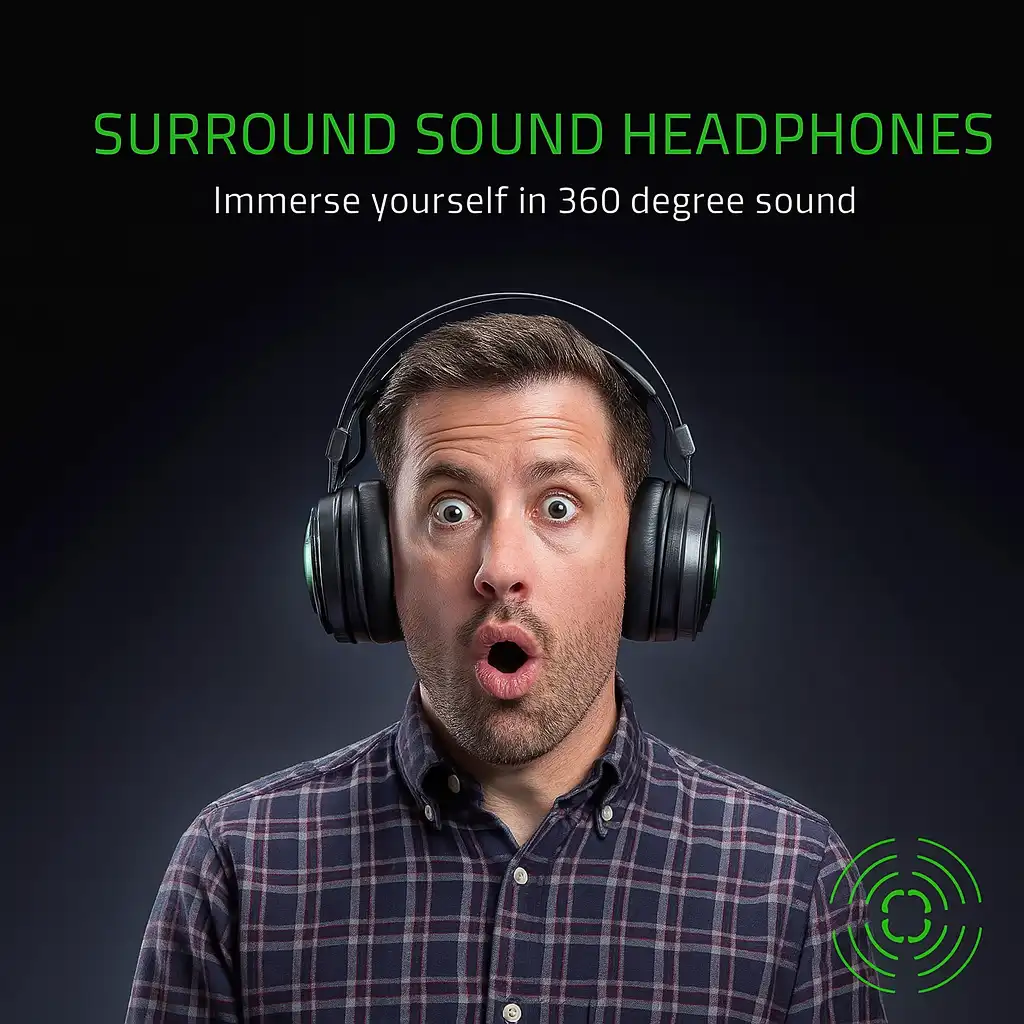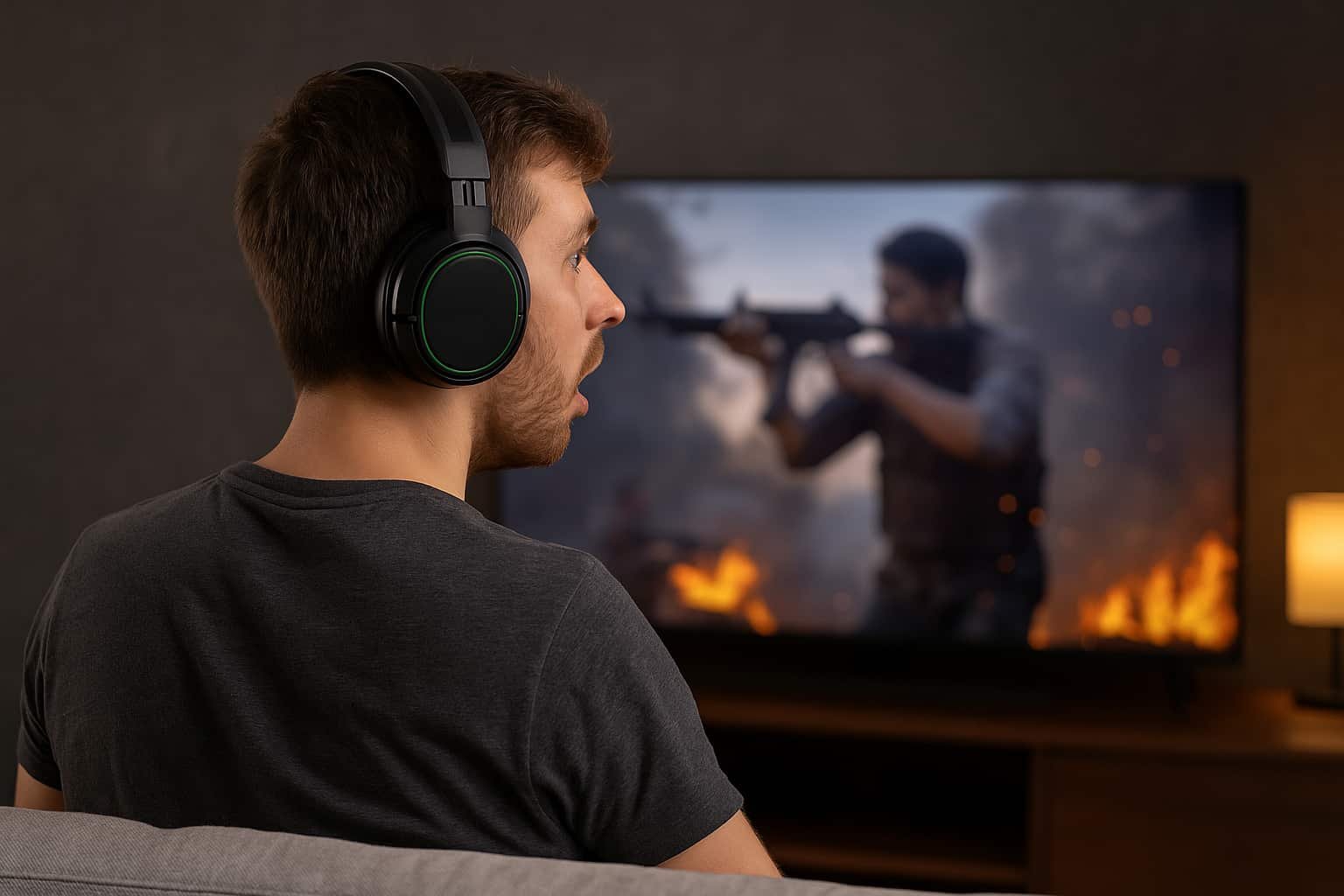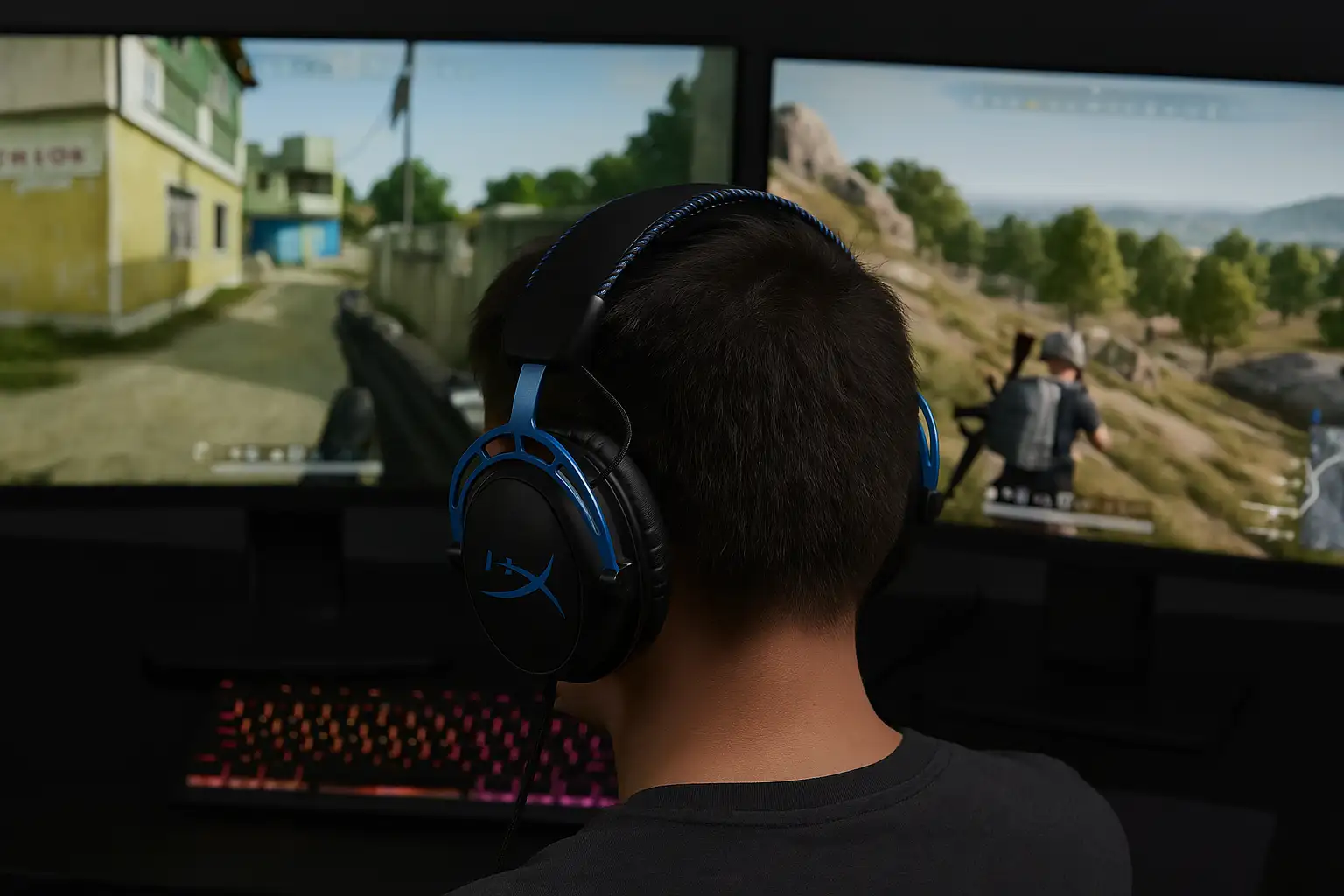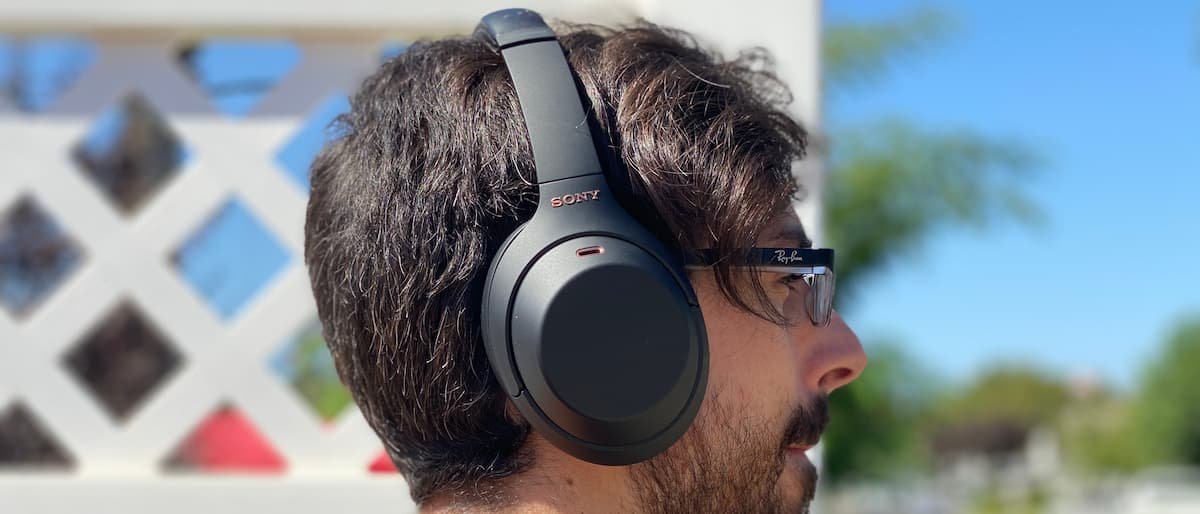If you’ve ever wondered what makes certain headphones feel more immersive, it almost always comes down to how they handle sound direction. Surround sound in headphones is designed to give you that feeling that audio isn’t just hitting your ears from the left and right — it feels like it’s coming from behind you, above you, or even from the far edge of the screen.
When we talk about what is surround sound headphones tech, we’re really talking about two core types: virtual and true surround sound systems. Headphones with surround sound usually simulate multi-channel setups (like 5.1 or 7.1) to create directional audio. In gaming, this is what helps you hear footsteps creeping up behind you or the subtle clink of a grenade bouncing on metal.

Stereo headphones send two channels — left and right. That’s it. Virtual surround adds software processing (usually digital signal processing or DSP) that tricks your brain into thinking sound is coming from different angles. True surround sound in headphones, on the other hand, uses multiple physical drivers inside each earcup, which aim sound into your ear from different angles. It’s bulkier and more expensive but can feel more natural.
How Does 7.1 Surround Sound Work in Headphones?
Most people throw around the phrase “7.1 surround” without really knowing what it means, so let’s break it down.
What is 7.1 surround sound headphones design trying to replicate? A typical 7.1 home theater setup uses eight channels: front left, front right, center, rear left, rear right, side left, side right, and one subwoofer channel for bass. That creates a spatial field that surrounds your entire head.

Now, how does 7.1 surround sound work in headphones? In true 7.1 surround headphones, this is replicated by multiple speakers inside the earcup, each one simulating one of those directional channels. In virtual 7.1 headphones, a single speaker in each cup plays processed sound that mimics that directionality.
For gaming, true 7.1 surround sound headphones are rare, expensive, and bulky. Virtual 7.1 surround sound headphones are far more common — and when done right, the difference is minimal.
Virtual vs True Surround Sound Headphones
So what’s the actual difference between true surround sound headphones and virtual surround sound headphones in real usage?
True 7.1 surround sound headphones are like having a tiny home theater on your head. They use multiple drivers in each ear, each one playing a different channel of audio. That gives a very realistic and immediate sense of spatial audio — but they tend to be heavier, more power-hungry, and often less comfortable for long gaming sessions.
Virtual surround uses one driver per ear and a smart processor that creates spatial cues using psychoacoustic tricks. You don’t need extra hardware, and that keeps the headphones lighter, more affordable, and easier to wear. For most gamers and movie lovers, a well-tuned virtual setup sounds great.
The downside? Some budget models get the processing wrong, and things can sound echoey or artificial.
Best Surround Sound Headphones in 2025 (Updated List)
I’ve gone through a lot of surround headphones over the past few years, and a few of them really stood out — not just on paper, but in actual use.

For gaming, I still think the SteelSeries Arctis Nova Pro Wireless is hard to beat if you want that premium build and super sharp spatial detail. It’s not cheap, but it feels worth it when every footstep in Valorant actually helps you react faster. On the other hand, the Razer BlackShark V2 Pro surprised me — it’s way more affordable but still nails the 7.1 virtual surround in a way that doesn’t feel muddy or artificial.
For movies, the Sony WH-1000XM5 still holds the crown if you want something that sounds big and immersive without needing to mess with EQ. The bass is deep, voices are clear, and it doesn’t feel like the sound is stuck inside your head. The Bose QuietComfort Ultra is also right there, and if comfort is a big deal for you (long Netflix sessions or flights), this one just melts onto your head.
If you’re working from home or in a lot of meetings, I’ve had a good experience with the Jabra Evolve2 85. It doesn’t look “gamer,” but it has solid surround presence and the mic is honestly one of the clearest I’ve used.
If you want something that can cover all of that — gaming, movies, Zoom calls — the Corsair Virtuoso RGB XT is my pick. It’s not perfect, but it does enough right to stay in my daily rotation.
None of these are just hype. They actually deliver when it comes to surround sound and spatial performance.
Best Surround Sound Headphones for Gaming
For serious gaming, the best surround sound gaming headphones let you hear everything before you even see it.

FPS games like CS2, Valorant, and Apex Legends are built around audio cues. Gaming surround sound headphones need to provide positional detail so exact you know what floor someone’s on just by their step.
The best gaming surround sound headphones right now?
- HyperX Cloud Alpha S – Great for competitive players.
- EPOS H6PRO – High-end wired precision.
- SteelSeries Arctis Nova Pro – Excellent virtual surround with software tuning.
Whether it’s best gaming headphones surround sound or something more immersive for story-driven titles, choose based on how you game.
Best Surround Sound Headphones for Movies and TV
The best surround sound headphones for movies really shine with wide soundstage, strong vocal presence, and deep bass.
Surround sound headphones for movies need to handle explosions, whispers, and sweeping scores all at once. You want headphones that support Dolby Atmos or DTS Headphone:X.
Some top options:
- Sony WH-1000XM5 – Wireless, Hi-Res, supports Dolby.
- Sennheiser Momentum 4 Wireless – Great dynamics and depth.
If you’re into surround sound headphones for TV or movie nights, these wireless surround sound headphones for TV offer comfort and cinema-like quality.
Wired vs Wireless Surround Sound Headphones
A common debate: do wireless headphones surround sound tech really hold up to wired?
Wired surround sound headphones offer lower latency and consistent audio delivery. They’re still the preferred choice for esports and competitive play.

Wireless surround sound headphones give you freedom, modern codecs, and easier setup. But you need to make sure latency is low and battery life doesn’t tank mid-session.
Some of the best wireless surround sound headphones today use Bluetooth 5.3, LDAC, or Qualcomm aptX Adaptive to keep lag low and quality high.
Look for:
- Razer BlackShark V2 Hyperspeed
- Sony INZONE H9
- Corsair HS80 Wireless RGB
Surround Sound Headphones by Brand
Over time, I’ve noticed that certain brands just handle surround sound better than others — not just on paper, but in real use.
Sony, for example, really nails the tuning. Their support for Dolby Atmos and spatial formats isn’t just a sticker on the box — it actually translates into that open, wide soundstage that makes gaming and movies more immersive. Add to that some of the best noise canceling tech out there, and you’ve got a solid all-rounder.

Then there’s Bose. If comfort matters to you — like wearing headphones for hours during movie nights or long work sessions — they’re on another level. But it’s not just comfort. The spatial clarity on some of their recent models feels way more natural than I expected.
Sennheiser is a different beast. The first thing I usually notice is the balance in the sound. Nothing feels exaggerated, mids are super clear, and their drivers just hold up over time. You won’t get flashy software, but you’ll get reliable performance every time you plug them in.
Each of these brands has its own vibe — it just depends on whether you care more about comfort, tuning, ANC, or platform support.
Budget and Niche Models to Consider
If you’re not ready to spend big, there are still excellent options.
- HYLAS RGB 50mm Surround Sound Gaming Headphones – Budget-friendly with big drivers and visual flair.
- OneOdio Pro10 – Wired alternative with decent spatial cues.
- Soundcore Life Q35 – ANC, surround, good battery life.
Best headphones for surround sound don’t always mean most expensive. Sometimes surround sound noise cancelling headphones at this price range surprise you.
How to Test Surround Sound in Headphones
Here’s how to run a real surround sound headphones test:
- Go on YouTube and search “7.1 surround test.”
- Use Dolby Access, DTS:X, or Windows Sonic if on PC.
- Play FPS games with rich positional audio.
- Try movies in Dolby format.
Calibrate within your OS audio settings or headphone software. That’s the only way to know if surround sound for headphones is actually doing its job.
Are Surround Sound Headphones Worth It? Final Thoughts
Surround sound for gaming isn’t just hype — when done right, it changes how you play. But it’s not for everyone.
If you’re into competitive play and need surgical precision, stereo might still be the way. But if you’re looking for immersion, awareness, and that “cinema in your head” feeling, surround is worth the jump.
Best headphones for surround sound gaming often land in the mid to upper range of pricing. But the extra investment usually means a lot more enjoyment, less ear fatigue, and better performance across the board.